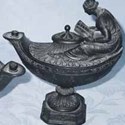Likely copied or adapted from engravings of the huge cache of antiquities excavated at the time in Herculaneum (Wedgwood was a subscriber to the English translation of the major work on the discoveries) they depict classical maidens atop pedestal urns encrusted with formal foliage, one figure reading, another seemingly ready to pour oil from a jug.
One of the lamps, that each measured 8in (20cm) across, was missing its cover but otherwise they were in fine condition. Estimated at £1000-1200, they sold to a collector in the room against three telephone lines for £2300.
Basalt was one of several mediums in which the Etruria factory excelled during the last quarter of the 18th century. Also in this collection - acquired from the 1950s to the 1970s and consigned for sale in Wiltshire from a country house in Scotland - were examples of the dry bodied cane ware, creamware and jasper dip.
Sold at £1420 was a c.1790 tricolour 18th century blue, white, lilac jasper plaque, 9in by 5in (23 x 13cm), decorated with frolicking putti playing blind man's buff in relief, while the same collector bid £500 for the pair of dry white and red bodied vases, bottom right, despite extensive cracks to both.
The top price of the sale was from another source, an early 19th century Davenport blue and white dinner service, familiar to auctioneer Charles Wells who, having grown up with the family who owned it, had eaten off its plates as a young man. There were 64 pieces in all, including a soup tureen, cover and stand, two small sauce tureens and three graduated dishes, each decorated with the Wild Rose design of garden flowers and urns. Probably owned by the family since new, c.1820, it was in fairly good overall condition and sold accordingly at £2500.
Classic Wedgwood collection
THE highlight of a 15-piece collection of Wedgwood ceramics offered for sale by Kidson-Trigg (15% buyer’s premium) of Highworth on May 26-27 was a pair of Wedgwood & Bentley black basalt oil lamps (one shown top right) that would have represented the height of fashion c.1775.








